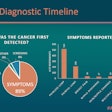
The COVID-19 pandemic drastically impacted imaging volume for radiology practices throughout the country and necessitated a variety of challenging operational adjustments. And some of these changes may be long-lasting, according to research published online July 9 in the Journal of the American College of Radiology.
A multi-institutional team of researchers led by Dr. Alexander Norbash of the University of California, San Diego (UCSD) assessed the impact of the pandemic on the imaging volume of a large national private practice coalition, as well as three academic medical systems in high COVID-surge regions and three in low-surge areas. After comparing volumes with the same weeks in 2019, they found total declines of imaging volume ranging from 40% to 70%, with the biggest declines in high-surge areas.
| Largest percentage decrease in weekly imaging volume for academic medical systems | |||
| 2019 | 2020 | Percentage difference | |
| Low-surge academic medical systems (aggregate) -- week 14 | 28,087 | 13,558 | -52% |
| High-surge academic medical systems (aggregate) -- week 15 | 75,088 | 26,253 | -65% |
Overall, the researchers found that large drops in imaging volume began in week 11 of 2020, with recovery beginning in week 17. The largest academic medical system in the study had the highest drop (70%), while the smallest system had the least amount of decline (40%).
On a modality basis, the greatest volume decreases were experienced with screening mammography and dual-energy x-ray absorptiometry (DEXA) scans, while the smallest drops were found in PET/CT, x-ray, and interventional radiology.
"The lowest drops in volume were seen with modalities where delays in imaging had greater perceived adverse consequences," the authors wrote.
Meanwhile, imaging volume drops in the private practice coalition -- Strategic Radiology -- tracked with the trends shown by the low-surge academic medical systems, according to the authors.
"The modalities with greatest initial drops, such as breast screening mammography and
DEXA scanning, also showed the greatest delays in trending towards volume recovery," they wrote. "Similarly, earliest recovery trends were seen with modalities demonstrating lower drops."
Inpatient imaging was also much less impacted than outpatient or emergency imaging. One high-surge academic medical system even reported an increase in inpatient volume during the pandemic.
In addition to analyzing imaging volumes, the authors also explored the adaptations made by practices, the risks of those changes, and the lessons learned. Reacting to the decline in volume and the operational requirements during the pandemic, the academic medical systems implemented a variety of strategies. These included adopting a wide range of frugality measures, shifting clinical and nonclinical staff offsite, and maximizing operational efficiency, according to the researchers.
These decisions come with their own challenges, however, including the risk of fragmenting teams, as well as the need to ensure fairness when frugality and financial adjustments were required, according to the authors.
The researchers believe that a host of operational, architectural, and strategic changes could wind up being durable adaptations even after the pandemic.
"Operational changes will likely include expanded hours, staggered radiologist shifts, and shorter MRI protocols," they wrote. "Architectural changes will include remote placement of nonclinical staff, and redesigned reading rooms. Strategic changes will include novel partnerships."



















